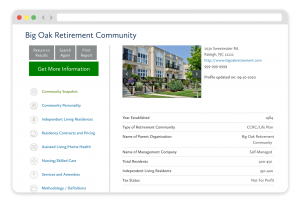As people consider various retirement community options, they typically have questions about things like services, amenities, and pricing. And it’s understandable since these factors will impact your day-to-day life should you decide to move there. But there’s another important question that should also be near the top of your list: How do I know if a retirement community is safe?
Everyone should feel safe in their home. Choosing a high-quality retirement community where you (or your loved one) will feel safe and comfortable is one of the most important decisions you’ll ever make. Let’s break down the key steps you should take to evaluate the safety of any retirement community, helping you make an informed senior living decision.
Assess the physical environment of the campus
The physical safety of any retirement community is the first thing to consider. A well-designed, secure environment can provide peace of mind and also helps prevent avoidable accidents.
- Town and neighborhood crime rates: Perhaps the first thing to consider is the overall safety of the retirement community’s location. You can examine crime data sorted by local law enforcement agency using the FBI’s online Crime Data Explorer tool or by ZIP code using crimegrade.org.
- Secure entry and exit points: Ensure that there are controlled access points into and out of residential quarters — especially for assisted living, memory care, or skilled nursing care. For independent living, people have different preferences of what makes them feel safe. Some may feel more secure in a gated community while others may prefer an open community. You should also as if security personnel is is on-site 24-7.
- Well-maintained infrastructure: Walk around the community and observe the condition of the facilities. Are the outside walkways and parking areas well-lit, free from cracks or other trip hazards, and accessible? Also, features like handrails in hallways, bathrooms, and other areas can prevent falls and make the environment safer.
- Accessible spaces: Evaluate the accessibility of common areas (like dining rooms, gardens, and recreational areas) for those with limited mobility. Even if you have no health issues now, keep in mind that elevators, ramps, and wide doorways are essential for safety and comfort should your mobility decline. Senior living providers are typically required to comply with various regulations set forth under HUD and/or ADA, depending on whether it offers only indpendent living or if it offers care services, or or both. Yet, even within these requirements some spaces may be more usable and accessible than others.
>> Related: Senior Living Affordability: A Top Priority For Choosing a Retirement Location
Evaluate the staff and care services
A retirement community’s staff plays a critical role in its safety and quality. Well-trained staff members — from the housekeeping staff to the food services members to the medical team (if applicable) — ensure that residents receive top-notch service and care.
- Background checks: The safety of residents depends on having trustworthy individuals on staff. Verify that all employees — as well as third-party vendors who come on campus — undergo thorough background checks, including criminal background screening and checking references.
- Staff qualifications: For all types of senior living communities, inquire about ongoing staff training programs, particularly those related to safety, CPR, and first aid. And for retirement communities with care service, ask about the qualifications of caregivers and other staff. Ensure that there are registered nurses (RNs), licensed practical nurses (LPNs), and certified nursing assistants (CNAs) available if necessary.
- Adequate staffing levels: A safe community should have an appropriate number of staff members to meet residents’ needs — particularly when it comes to those residents requiring care. Ask about the staff-to-resident ratio, especially during peak hours and weekends, to be sure your requests and needs will be met in a timely fashion. The recommended standard for assisted living, for example, is 8 staff for every 1 resident, but other factors also come into play. For example, the ratio may be lower over night when most residents are sleeping and other non-nursing staff members may be available to provided additional support with non-care related needs. Note that in 2024 a final ruling from CMS on new nursing facility staffing requirements took effect, which will require about 4 out of every 5 nursing homes to increase staffing and may provide to be financially unsustainable for some of these providers.
>> Related: Evaluating Care, Quality, and Access at a CCRC’s Healthcare Center
Inquire about health and safety protocols
Health and safety protocols are especially important in preventing illness, accidents, and injury. Make sure that the retirement community has the following in place:
- Disaster preparedness plans: Every retirement community should have a disaster preparedness plan in place, particularly for natural disasters or fire evacuations. There should be visible evacuation routes, smoke detectors, and fire alarms in every residence and also in indoor common areas.
- Medical emergency response: Ask about the community’s procedures for handling medical emergencies. Is there a nurse or doctor on-site 24/7? Are all staff trained in CPR and first aid? Are automated external defibrillators (AEDs) available throughout the campus? Many retirement communities also have emergency response systems, such as pull cords in the bathrooms or even remote wearable devices for residents.
- Infection control: In the wake of the COVID-19 pandemic, we’ve been reminded of the importance of infection control. Ask how the community manages infections, including flu, norovirus, or other contagious diseases, and their protocols for isolating infected individuals and sanitizing common areas.
- Fall prevention initiatives: CDC data reveals that falls are the top cause of injury in older adults, so the design of any senior living community should be free of trip and fall hazards. Inquire about the community’s fall prevention measures, particularly for vulnerable assisted living and skilled nursing care residents.
>> Related: What to Ask About a CCRC’s Emergency Preparedness
Consider the community’s reputation
Reputation is one of the best indicators of how a retirement community prioritizes resident safety. Some sources you might want to investigate include:
- Speak with current residents and staff: The first-hand accounts of people living and working within a retirement community are one of the best ways to evaluate its safety. Ask about their experiences: Are they comfortable in their surroundings? Do they feel secure? Do they know who to contact in case of an emergency? What has been the community’s response time for any health or safety issues that have arisen?
- Online reviews and testimonials: Another way to get boots-on-the-ground insights is to check online reviews, ratings, and testimonials from residents and residents’ families. Websites like Yelp and Google Reviews offer firsthand experiences that can give you insights into any safety issues (or lack thereof) at a community.
- Regulatory reports: Depending on where you live, retirement communities might be regulated by state or federal agencies. Look for the community’s inspection reports, violation history, and compliance records, which can provide detailed information on the safety and care standards of the community. You can ask the community management for these reports; if they resist sharing them, it can be a red flag. Check online to see if they’re publicly available, or reach out to your state’s long-term care ombudsman program (LTCOP) about any complaints they’ve received. If the community has on-site care facilities that are Medicare-certified, those reports can be helpful too. (Keep in mind not all retirement communities with care services pursue Medicare certification, so not being certified may not necessarily be indicative of any quality deficiencies.)
>> Related: Long-Term Care Ombudsman Programs Support LTC Residents
Examine the safety features and amenities
Beyond a retirement community’s physical infrastructure and safety practices, you should also consider its amenities and features that support residents’ overall safety and well-being. Afterall, part of feeling safe and secure in a community is knowing that you have a solid support system in place.
- Transportation services: Many retirement communities offer transportation to medical appointments, grocery shopping, and recreational activities. Safe and reliable transportation can help residents maintain independence and prevent car accidents.
- Recreational and social programs: A good retirement community offers activities that keep residents active, both physically and mentally, and helps them form a supportive network. Such social engagement can reduce health risks like depression, isolation, and even physical decline. Ask about the variety and frequency of these programs.
- Wellness programs: A focus on wellness can greatly enhance residents’ overall safety and health. In fact, with the increased societal focus on whole-person wellness, the future of senior living is likely to be shaped in large part by wellness programs. Therefore, you should ask not only about physical fitness and nurtirional programs, but also about mental, emotional, spiritual, and vocational opportunities and programming.
>> Related: Can Retirement Communities Help Prevent a Sedentary Lifestyle?
Understand policies on family involvement
Particularly for older adults living in retirement communities with care services, families play a vital role in ensuring that their loved ones are well cared for. Be sure you understand the community’s policies on family involvement and communication, and be attuned to any red flags.
- Communication protocols: Especially for those requiring care services within a retirement community, regular updates and transparent communication with loved ones are essential. How does the community communicate with families about safety, health, and emergencies?
- Visitation policies: Some retirement communities may have restrictions on visiting hours or visitor policies for security purposes, again, particularly in any healthcare-related sections of the community. Understanding these rules ensures you can remain actively involved in your loved one’s care.
- Feedback mechanisms: A good community should welcome input from residents and families, especially on the topics of resident safety and quality of care. Ask what the avenues are for providing feedback or reporting any concerns that might arise.
>> Related: A Senior Living Solution That Keeps Couples with Different Care Needs Together
Know if a retirement community is safe before moving
When looking at retirement communities, people often focus on the tangibles: residences’ square footage and floor plans, dining options, or amenities. But one of the very first questions you should be asking is, “How do I know if this retirement community is safe?”
A retirement community is a place that will be your home. And as with anyplace you live, you want to feel comfortable and safe there in every respect. You want to know that you will be safe inside, as well as walking to and from your residence. You want to feel certain that if you are in need of care services, you will be well-taken care of by properly trained, high-quality caregivers adhering to safety protocols.
Ultimately, the safety of a retirement community should provide peace of mind for both the resident and their loved ones. It’s not just about preventing harm but also creating an environment where residents can safely live with independence, dignity, and joy.
By taking the time to visit a retirement community, ask the right questions, and evaluate the safety features, you’ll be better prepared to make an informed senior living decision, be it for yourself or a loved one.

FREE Detailed Profile Reports on CCRCs/Life Plan Communities
Search Communities






